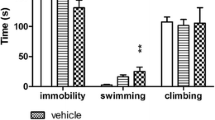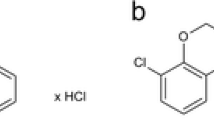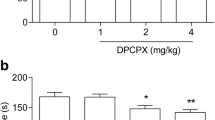Abstract
This study examined the abilities of 5-hydroxytryptamine (5-HT) agonists with varying selectivity for different subtypes of 5-HT receptors to produce antidepressant-like behavioral effects in the forced swim test in rats. The 5-HT1A agonists 8-OH-DPAT (0.125–1.0 mg/kg, SC) and tandospirone (SM-3997) (5–20 mg/kg, SC) both produced dose-related decreases in immobility time following subchronic treatment in rats. These effects were similar to those of the tricyclic antidepressants imipramine (5–15 mg/kg) and desipramine (5–15 mg/kg). In addition, the 5-HT1A agonists, buspirone (20 mg/kg), gepirone (20 mg/kg) and ipsapirone (10 and 20 mg/kg) demonstrated antidepressant-like effects. Other groups of rats treated subchronically with each of the 5-HT1A agonists or antidepressants showed no increase in locomotor activity, so that general changes in activity could not account for the reduction of immobility time in the forced swim test. 5-HT agonists selective for other receptor subtypes, such as the 5-HT1B/1C agonistm-CPP (5 mg/kg) and the 5-HT2/1C agonist DOB (1 mg/kg), were not effective in this behavioral test. The benzodiazepine diazepam (5 mg/kg) also failed to reduce immobility time, suggesting that anxiolytic properties of 5-HT1A agonists did not mediate this behavioral effect. A common metabolite of some of the 5-HT1A agonists, 1-PP, was ineffective in reducing immobility time. The stimulantd-amphetamine (2 mg/kg) significantly reduced immobility time but also significantly increased locomotor activity. Pretreatment with the 5-HT synthesis inhibitor PCPA alone did not alter immobility time, and did not alter the antidepressant-like effects of 8-OH-DPAT or tandospirone, suggesting that the 5-HT1A agonists are producing their antidepressant-like effects through postsynaptic 5-HT1A receptors. These results suggest that 5-HT1A agonists may have antidepressant efficacy and act as a novel class of antidepressant drug.
Similar content being viewed by others
References
Amsterdam JD, Berwish N, Potter L, Rickels K (1987) Open trial of gepirone in the treatment of major depressive disorder. Curr Ther Res 41:185–193
Anisman H, Irwin J, Sklar S (1979) Deficits of escape performance following catecholamine depletion: implications for behavioural deficits induced by uncontrollable stress. Psychopharmacology 64:163–170
Bianchi G, Garattini S (1988) Blockade ofα 2-adrenoceptors by 1-(2-pyrimidinyl)-piperazine (PmP) in vivo and its relation to the activity of buspirone. Eur J Pharmacol 147:343–350
Borsini F, Meli A (1988) Is the forced swimming test a suitable model for revealing antidepressant activity? Psychopharmacology 94:147–160
Caccia S, Conti I, Vigano G, Garattini S (1986) 1-(2-Pyrimidinyl)-piperazine as active metabolite of buspirone in man and rat. Pharmacology 33:46–51
Carli M, Prontera C, Samanin R (1989) Effect of 5-HT1A agonists on stress-induced deficit in open field locomotor activity of rats: evidence that this model identifies anxiolytic-like activity. Neuropharmacology 28:471–476
Cervo L, Samanin R (1987) Potential antidepressant properties of 8-hydroxy-2-(di-n-propylamino)tetralin, a selective serotonin1A receptor agonist. Eur J Pharmacol 144:223–229
Cervo L, Grignaschi G, Samanin R (1988a) Different effects of intracerebral and systemic administration of buspirone in the forced swim test: involvement of a metabolite. Life Sci 43:2095–2102
Cervo L, Grignaschi G, Samanin R (1988b) 8-Hydroxy-2-(di-n-propylamino)tetralin, a selective serotonin1A receptor agonist, reduces the immobility of rats in the forced swimming test by acting on the nucleus raphe dorsalis. Eur J Pharmacol 158:53–59
Chouinard G (1985) A double-blind controlled clinical trial of fluoxetine and amitriptyline in the treatment of outpatients with major depressive disorder. J Clin Psychiatry 46:32–37
Cioli V, Corradino C, Piccinelli D, Rocchi MG, Valerji P (1984) A comparative pharmacological study of trazodone, etoperidone and 1 (m-chlorophenyl)piperazine. Pharmacol Res Commun 16:85–100
Conn PJ, Sanders-Bush E (1987) Relative efficacies of piperazines at the phosphoinostide hydrolysis-linked serotonergic (5-HT2 and 5-HT1c) receptors. J Pharmacol Exp Ther 242:552–557
Coppen AJ, Doogan DP (1988) Serotonin and its place in the pathogenesis of depression. J Clin Psychiatry 49 (Suppl): 4–11
Dourish CT, Hutson PH, Kennett GH, Curzon G (1986) 8-OH-DPAT-induced hyperphagia: its neural basis and possible therapeutic relevance. Appetite 7 [Suppl]:127–140
Eison MS, Eison AS (1984) Buspirone as a midbrain modulator: anxiolysis unrelated to traditional benzodiazepine mechanisms. Drug Dev Res 4: 109–119
Eison AS, Eison MS, Stanley M, Riblet LA (1986) Serotonergic mechanisms in the behavioral effects of buspirone and gepirone. Pharmacol Biochem Behav 24:701–707
Engel JA, Hjorth S, Svensson K, Carlsson A, Liljequist S (1984) Anticonflict effect of the putative serotonin receptor agonist 8-hydroxy-2-(di-N-propylamino)tetraline (8-OH-DPAT). Eur J Pharmacol 105:365–368
Feighner JP, Cohn JB (1985) Double-blind comparative trials of fluoxetine and doxepin in geriatric patients with major depressive disorder. J Clin Psychiatry 46:20–25
Giral Ph, Martin P, Soubrie Ph, Simon P (1987) Reversal of helpless behaviour in rats by putative 5-HT1A agonists. Biol Psychiatry 23:237–242
Glennon RA, Titeler M, McKenney JD (1984) Evidence for 5-HT2 receptor involvement in the mechanism of action of hallucinogenic agents. Life Sci 35:2205–2511
Goldberg HL, Finnerty RJ (1979) The comparative efficacy of buspirone and diazepam in the treatment of anxiety. Am J Psychiatry 136:1184–1187
Gozlan H, Ei Mestikaway S, Bourgoin S, Hall M, Pichat L, Glowinski J, Hamon M (1983a) The specific labeling of pre- and postsynaptic 5-HT receptors by3H-PAT in the rat CNS. Naunyn-Schmiedeberg's Arch Pharmacol 324S:73
Gozlan H, EI Mestikawy S, Pichat L, Glowinski J, Hamon M (1983b) Identification of presynaptic serotonin autoreceptors using a new ligand:3H-PAT. Nature 305:140–142
Kennett GA, Dourish CT, Curzon G (1987) Antidepressant-like action of 5-HT1A agonists and conventional antidepressants in an animal model of depression. Eur J Pharmacol 134:265–274
Kitada Y, Miyauchi T, Satoh A, Satoh S (1981) Effects of antidepressants in the rat forced swimming test. Eur J Pharmacol 72:145–152
Koe BK, Weissman A (1966)p-Chlorophenylalanine: A specific depletor of brain serotonin. J Pharmacol Exp Ther 154:499–516
Leysen JE, Niemegeers CJE, Van Nueten JM, Laduron PM (1982) [3H]Ketanserin (R 41 468), a selective3H-ligand for serotonin 2 receptor binding sites. Mol Pharmacol 21:301–314
Lowry OH, Rosenbrough NJ, Farr AL, Randall RJ (1951) Protein measurement with the Folin phenol reagent. J Biol Chem 193:265–275
Lucki I, Kreider MS, Simansky KJ (1988) Reduction of feeding behavior by the serotonin uptake inhibitor sertraline. Psychopharmacology 96:289–295
Lucki I, Ward HR, Frazer A (1989a) Effect of 1-(m-chlorophenyl)-piperazine and 1-(m-trifluoromethylphenyl)piperazine on locomotor activity. J Pharmacol Exp Ther 249:155–164
Lucki I, Wieland S, Andrews R (1989b) Differential modulation of the stimulus properties of 5-HT agonists by 5-HT neurons. Soc Neurosci Abstr 15:226
Marek GJ, Li AA, Seiden LS (1989) Evidence for involvement of 5-hydroxytryptamine 1 receptors in antidepressant-like drug effects on differential-reinforcement-of-low-rate 72-second behavior. J Pharmacol Exp Ther 250:60–71
Meltzer HY, Lowy MT (1987) The serotonin hypothesis of depression. In: Meltzer HY (ed) Psychopharmacology: the third generation of progress. Raven Press, New York, pp 513–526
Middlemiss DN, Fozard JR (1983) 8-Hydroxy-2-(di-n-propyami-no)tetralin discriminates between subtypes of the 5-HT1 recognition site. Eur J Pharmacol 90:151–153
O'Donnell JM, Seiden LS (1983) Differential-reinforcement-of-low-rate 72-second schedule: selective effects of antidepressant drugs. J Pharmacol Exp Ther 224:80–88
Pazos A, Hoyer D, Palacios JM (1984) The binding of serotonergic ligands to the porcine choroid plexus: characterization of a new type of serotonergic recognition site. Eur J Pharmacol 6:539–546
Pedigo NW, Yamamura HI, Nelson DL (1981) Discrimination of multiple [3H]5-hydroxytryptamine binding sites by the neuroleptic spiperone in rat brain. J Neurochem 37:220–226
Peroutka SJ (1985) Selective interaction of novel anxiolytics with 5-hydroxytyptamine1A receptors. Biol Psychiatry 20:971–979
Peroutka SJ, Snyder SH (1979) Multiple serotonin receptors: differential binding of3H-serotonin,3H-lysergic acid diethylamide and3H -spiroperidol. Mol Pharmacol 14:687–699
Porsolt RD, Anton G, Blavet N, Jalfre M (1978) Behavioral despair in rats: a new model sensitive to antidepressant treatments. Eur J Pharmacol 47: 379–391
Porsolt RD, Bertin A, Blavet N, Deniel M, Jalfre M (1979) Immobility induced by forced swimming in rats: effects of agents which modify central catecholamine and serotonin activity. Eur J Pharmacol 57:201–210
Reimherr FW, Byerley WF, Ward MF, Lebegue BJ, Wender PH (1988) Sertraline, a selective inhibitor of serotonin uptake, for the treatment of outpatients with major depressive disorder. Psychopharmacol Bull 24:200–205
Schnellmann RG, Waters SJ, Nelson DL (1984) [3H]5-hydroxytryptamine binding sites: species and tissue variation. J Neurochem 42:65–70
Schweizer EE, Amsterdam JD, Rickels K, Kaplan M, Droba M (1986) Open trial of buspirone in the treatment of major depressive disorder. Psychopharmacol Bull 22:183–185
Sherman AD, Sacquitne JL, Petty F (1982) Specificity of the learned helplessness model of depression. Pharmacol Biochem Behav 15:449–454
Shimizu H, Hirose A, Tatsuno T, Nakamura M, Katsube J (1987) Pharmacological properties of SM-3997: a new anxioselective anxiolytic candidate. Jpn J Pharmacol 45:493–500
Shimizu H, Tatsuno T, Hirose A, Tanaka H, Kumasaka Y, Nakamura M (1988) Characterization of the putative anxiolytic SM-3997 recognition sites in rat brain. Life Sci 42:2419–2427
Sills MA, Wolfe BB and Frazer A (1984) Determination of selective and nonselective compounds for the 5-HT1A and 5-HT1B receptor subtypes in rat frontal cortex. J Pharmacol Exp Ther 231:480–487
Soubrie Ph, Martin P, El Mestikawy S, Thiebot MH, Simon P, Hamon M (1986) The lesion of serotonergic neurons does not prevent antidepressant-induced reversal of escape failures produced by inescapable shocks in rats. Pharmacol Biochem Behav 25:1–6
Titeler M, Lyon RA, Glennon RA (1988) Radioligand binding evidence implicates the brain 5-HT2 receptor as a site of action for LSD and phenylisopropylamine hallucinogens. Psychopharmacology 94:213–216
Traber J, Davies MA, Dompert WU, Glaser T, Schuurman T, Seidel PR (1984) Brain serotonin receptors as a target for the putative anxiolytic TVX Q 7821. Brain Res Bull 12:741–744
Tricklebank MD, Forler C, Fozard JR (1985) The involvement of subtypes of the 5-HT1 receptor and of catecholaminergic systems in the behavioural response to 8-hydroxy-2-(di-n-propyamino)tetralin in the rat. Eur J Pharmacol 106:271–282
Young R, Urbancic A, Emrey TA, Hall PC, Metcalf G (1987) Behavioral effects of several new anxiolytics and putative anxiolytics. Eur J Pharmacol 143:361–371
Author information
Authors and Affiliations
Rights and permissions
About this article
Cite this article
Wieland, S., Lucki, I. Antidepressant-like activity of 5-HT1A agonists measured with the forced swim test. Psychopharmacology 101, 497–504 (1990). https://doi.org/10.1007/BF02244228
Received:
Revised:
Issue Date:
DOI: https://doi.org/10.1007/BF02244228




